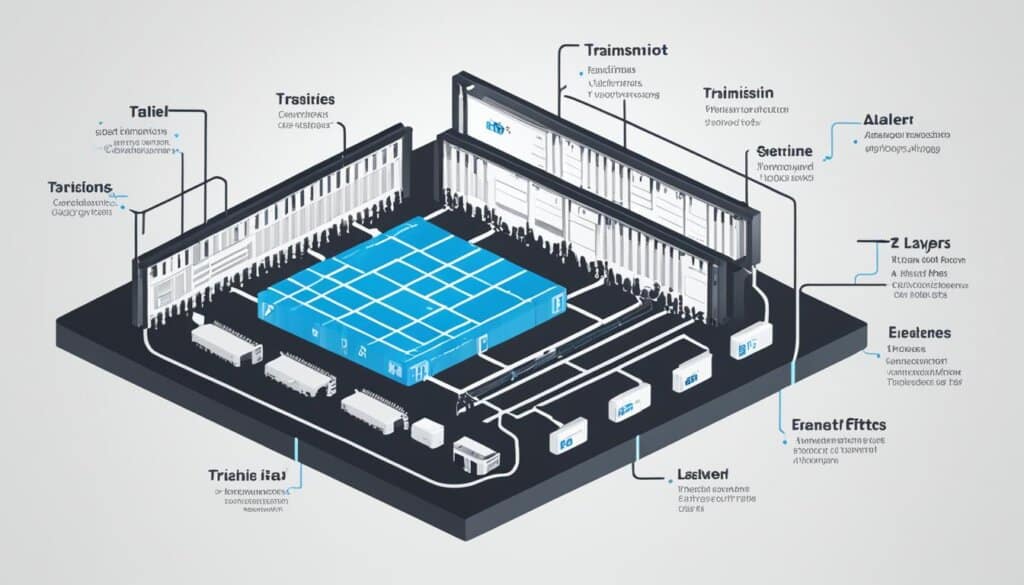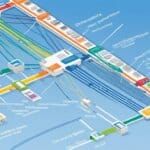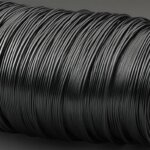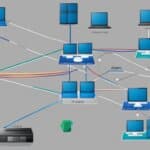Table of Contents
Ethernet technology has revolutionized networking systems, allowing for seamless data exchange between devices in a network. Understanding the functions and role of Ethernet is essential for anyone involved in modern networking.
As the most widely used Data Link Layer protocol, Ethernet enables devices to communicate effectively and efficiently. It provides a standardized framework for transmitting data over physical cables, ensuring reliable connectivity and fast data transfer speeds.
In this guide, we will delve into the history of Ethernet, explore its frame structure, address mechanisms, the minimum frame length, and the different types of Ethernet cables and ports. By the end, you’ll have a comprehensive understanding of Ethernet technology, its functions, and its integral role in networking systems.
Let’s dive into the world of Ethernet and discover its fascinating intricacies.
Some Ethernet History
Ethernet, a widely used networking technology, has a fascinating history in its development and evolution. Let’s delve into the key milestones and versions of this remarkable technology.
Ethernet Development
Ethernet was first implemented in 1976 when Robert Metcalfe and his team at Xerox Corporation developed a local area network (LAN) technology to connect computers and share resources. This early version of Ethernet operated at a speed of 2.94 megabits per second (Mbps). However, it wasn’t until 1978 that a more standardized version, known as Ethernet II, was published.
Introduction of IEEE 802.3
In 1983, the Institute of Electrical and Electronics Engineers (IEEE) standards association released the IEEE 802.3 standard, which further advanced Ethernet technology. IEEE 802.3 defined the access method, data encapsulation, and physical characteristics that Ethernet networks should adhere to.
The IEEE 802.3 standard brought significant improvements to Ethernet, including increased data rates and compatibility with various network media types. It became another widely used version of Ethernet and set the foundation for the future development of the technology.
Today, Ethernet II and IEEE 802.3 are both commonly referred to as “Ethernet.” These versions have played a crucial role in shaping the modern Internet, powering vast networks and facilitating seamless data communication.
Ethernet has come a long way since its inception in the mid-1970s. Its continued development and standardization have enabled reliable and high-speed connectivity in countless industries and everyday life.
Stay tuned for the next sections, where we’ll explore the Ethernet frame, addresses, the importance of minimum frame length, and the different types of Ethernet cables and ports.
Ethernet Frame Overview
In order to understand Ethernet technology, it is important to grasp the structure of an Ethernet frame. An Ethernet frame consists of several components that work together to facilitate the transmission of data across a network.
The frame begins with an 8-byte preamble, which serves as a synchronization signal for the receiving device. This allows the receiving device to detect the start of a new frame and synchronize its internal clock.
Following the preamble, the frame contains the destination and source addresses. These addresses, each consisting of 6 bytes, identify the devices that are sending and receiving the frame. They play a crucial role in ensuring that the data reaches the intended recipient.
Next, the frame contains a type/length field, which is 2 bytes in size. This field indicates the type of payload that is carried by the frame or specifies the length of the payload.
The payload itself is contained in the data and padding section of the frame. This section can vary in size from 46 to 1500 bytes, depending on the specific Ethernet standard being used. The payload can include various types of data, such as network layer packets.
Finally, the frame includes a 4-byte checksum. This checksum is used to ensure the integrity of the data during transmission. It allows the receiving device to verify that the data has not been corrupted or altered during transmission.
To visually illustrate the Ethernet frame structure, refer to the table below:
| Component | Size (Bytes) |
|---|---|
| Preamble | 8 |
| Destination Address | 6 |
| Source Address | 6 |
| Type/Length Field | 2 |
| Data and Padding | 46-1500 |
| Checksum | 4 |
Understanding the Ethernet frame structure is essential for networking professionals as it allows for efficient and reliable data transmission across Ethernet networks.

How Ethernet Addresses Work
Ethernet addresses, also known as MAC (Media Access Control) addresses, are used to identify devices on a network. These addresses play a crucial role in ensuring data is transmitted to the intended devices.
An Ethernet address consists of 48 bits, or 6 bytes, expressed as a sequence of hexadecimal digits. The first three bytes represent the Organizational Unique Identifier (OUI), which identifies the manufacturer of the network interface card (NIC). The remaining three bytes, known as the NIC’s serial number, uniquely identify the device.
One type of Ethernet address is the unicast address. This address is used to identify a specific device on the network. When a device wants to send data to another device, it uses the unicast address of the intended recipient as the destination address in the Ethernet frame.
Another type of Ethernet address is the multicast address. A multicast address identifies a group of devices on the network, allowing data to be sent to all devices within the group. Multicast addresses are used for communication protocols that require data to be simultaneously received by multiple devices.
It’s important to note that Ethernet addresses have bits that indicate whether they are globally unique or locally administered. A globally unique address is assigned by the IEEE (Institute of Electrical and Electronics Engineers) and ensures that no two devices worldwide have the same address. On the other hand, a locally administered address is assigned by the device manufacturer and is not guaranteed to be globally unique.
To better understand how Ethernet addresses work, consider the following example:
Imagine a large office network with multiple devices connected. Each device, such as computers, printers, and switches, has a unique MAC address. Let’s say a computer wants to send a file to a printer on the network. The computer will address the Ethernet frame with the unicast address of the printer, ensuring that the data is delivered only to the intended recipient. Conversely, if a device wants to stream a video to multiple computers on the network, it would use a multicast address to reach all the devices within the multicast group simultaneously.
Ethernet Address Types:
There are different types of Ethernet addresses, including:
- Unicast Address: Identifies a specific device on the network.
- Multicast Address: Identifies a group of devices on the network.
- Globally Unique Address: Assigned by the IEEE, ensuring worldwide uniqueness.
- Locally Administered Address: Assigned by the device manufacturer, not guaranteed to be globally unique.
Understanding how Ethernet addresses work is essential for ensuring efficient and reliable data transmission in network environments.
Why Does an Ethernet Frame Have a Minimum Length?
Ethernet frames have a minimum length requirement of 64 bytes, with a minimum data length of 46 bytes. This minimum length is essential for the efficient handling of collisions in Ethernet networks. Collisions occur when two devices attempt to transmit data simultaneously, resulting in the corruption of both transmitted signals. By enforcing a minimum frame length, Ethernet ensures that collisions are properly detected and resolved.
Handling collisions is crucial in Ethernet networks as it allows for the efficient sharing of network resources. When a collision occurs, devices on the network need to detect the collision and take appropriate action, such as retransmitting the data after a random delay. By having a minimum frame length, Ethernet enables devices to recognize collisions by detecting the absence of a carrier signal.
The minimum frame length also helps ensure that the impact of collisions is minimized. When a collision occurs, the length of the frame is stretched using padding bits to meet the minimum requirement. This process guarantees that the collision signal is propagated throughout the network, allowing other devices to detect and respond to it effectively.
Without the minimum frame length requirement, collisions in Ethernet networks would cause inefficiencies and delays in data transmission. The minimum length ensures that collisions are detected and resolved promptly, enabling devices to share the network resources efficiently.
Impact of Minimum Frame Length on Network Performance
Scenario Effect on Network Performance Shorter Frame Length Increased likelihood of collisions, leading to greater network congestion and reduced data throughput. Longer Frame Length Decreased likelihood of collisions, but may lead to wastage of network resources due to unnecessary padding bits. The impact of the minimum frame length on network performance is evident in different scenarios. Shorter frame lengths increase the likelihood of collisions, resulting in higher network congestion and decreased data throughput. On the other hand, longer frame lengths decrease the probability of collisions but may lead to the wastage of network resources due to the inclusion of unnecessary padding bits.
- Minimum frame length ensures efficient collision detection and resolution.
- Collisions can cause network congestion and reduced data throughput.
- Longer frame lengths reduce the likelihood of collisions but may waste network resources.
In summary, the minimum frame length requirement in Ethernet networks plays a vital role in handling collisions effectively. By enforcing this requirement, Ethernet enables devices to detect and resolve collisions promptly, ensuring the efficient sharing of network resources. It is a key feature that contributes to the reliable and high-performance operation of Ethernet networks.
Different Types of Ethernet Cables and Ports
When it comes to Ethernet networks, the choice of cables and ports is crucial for optimal performance. Ethernet cables are available in various categories, each designed to meet specific bandwidth and data rate requirements. Some of the commonly used categories include Cat 5, Cat 5e, Cat 6, Cat 6a, Cat 7, and Cat 8.
Cat 5 cables, often referred to as Category 5 cables, are the most basic option and offer decent speeds for regular use. They are suitable for home networks or small offices. Cat 5e cables, on the other hand, provide improved performance and reduced crosstalk compared to Cat 5, making them ideal for larger networks or applications that require higher data rates.
Cat 6 and Cat 6a cables offer even higher speeds and better noise reduction, making them suitable for demanding applications such as video streaming or online gaming. Cat 7 cables are designed for more specialized purposes, offering even greater shielding and support for higher frequencies. As for Cat 8 cables, they are relatively new and provide exceptional data transfer rates, making them suitable for enterprise-level networks.
Alongside the choice of cables, Ethernet ports play a crucial role in determining network speeds. Most devices today come with Gigabit Ethernet ports, which support data transfer rates up to 1 gigabit per second (Gbps). However, some devices now feature ports that support higher speeds, such as 10 Gbps or even 100 Gbps, catering to the growing demand for faster connections.
Lastly, Ethernet switches are essential components for connecting multiple devices in a network. They enable efficient data transmission between devices and help manage network traffic effectively. By utilizing Ethernet switches, you can create a reliable and scalable network infrastructure that meets the needs of your organization.
FAQ
What is Ethernet?
Ethernet is the most widely used Data Link Layer protocol for devices connected by physical cables. It enables the exchange of data between devices in a network and plays a crucial role in modern networking systems.
When was Ethernet first implemented?
Ethernet was first implemented in 1976.
What are the different versions of Ethernet?
Ethernet II was published in 1978, and in 1983, the IEEE standards association released the IEEE 802.3 standard, which became another widely used version of Ethernet. Today, Ethernet II and IEEE 802.3 are both commonly referred to as “Ethernet.”
What components make up an Ethernet frame?
An Ethernet frame consists of an 8-byte preamble, destination and source addresses (each 6 bytes), a type/length field (2 bytes), data and padding (46-1500 bytes), and a 4-byte checksum.
How are Ethernet addresses used?
Ethernet addresses are used to identify devices on a network. They can be unicast addresses, which identify a specific device, or multicast addresses, which can be received by multiple devices.
What is the minimum length of an Ethernet frame?
Ethernet frames have a minimum length of 64 bytes, with a minimum data length of 46 bytes. This minimum length is necessary to allow for the proper handling of collisions in Ethernet networks.
What are the different types of Ethernet cables?
Ethernet cables come in various categories, including Cat 5, Cat 5e, Cat 6, Cat 6a, Cat 7, and Cat 8. Each category has different bandwidth and data rate capabilities.
What speeds can Ethernet ports support?
Ethernet ports on devices can support different speeds, commonly Gigabit Ethernet or higher.
How are multiple devices connected to a network?
Ethernet switches are used to connect multiple devices to a network.












